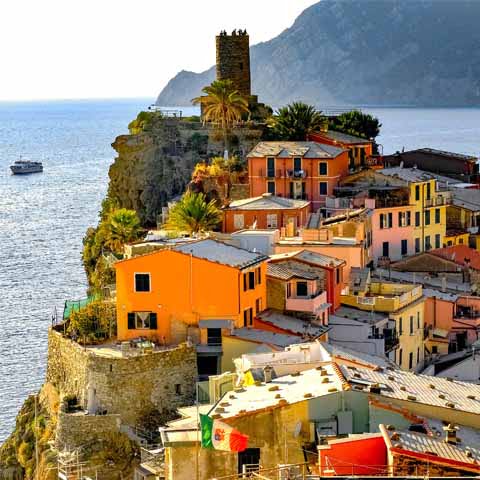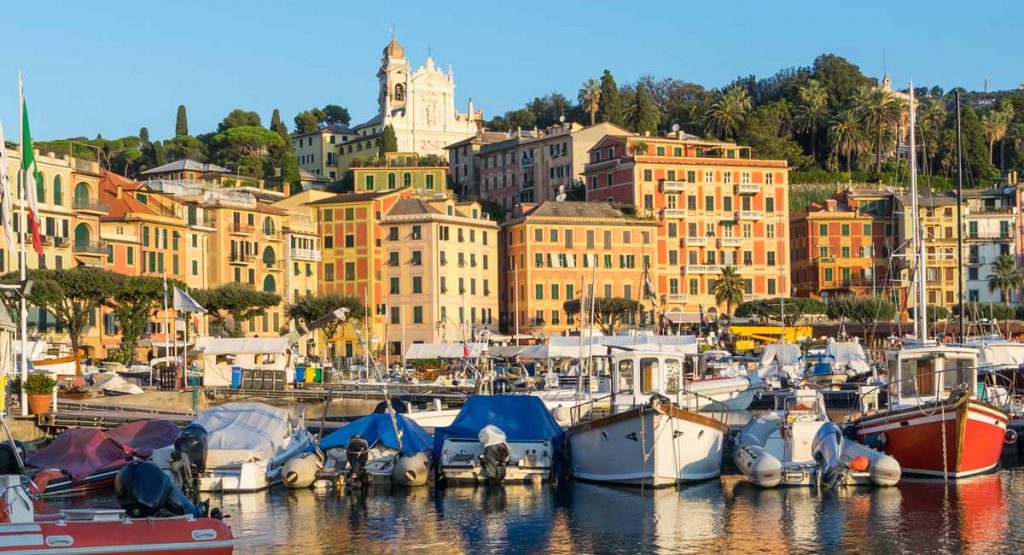While the Cinque Terre area is known for its quaint ambiance and scenic foot paths, this region of “five villages” is also well rounded in cultural experiences. From deep historic roots evident in the architecture to various art forms that can be admired throughout the area, these coastal fishing towns have developed their own unique culture over the centuries.
The many miles of stone support walls along the terraced hillsides have long been a central aspect of the region’s topography. Beginning in the thirteenth century, the locals transformed the landscape by carving terraces along the hills and down to the sea. The resulting land required continuous care in order to be suitable for agriculture. For centuries, the terraces provided locals with a canvas for the grapes and other crops they would come to be known for. Although, as competition increased throughout Europe into the 20th century, many local producers found that they could not compete with the high production volumes of larger wineries. In 1973, Italy’s governing body recognized the value in Cinque Terre’s land by granting it Designation of Controlled Origin (or D.O.C.) status in hopes of changing the fate of the local crops and the region’s overall cultural landscape. In addition, the area was declared a UNESCO World Heritage Site in 1997, and the Cinque Terre National Park was founded in 1999.
The agriculture of the villages continued to struggle, and many vineyards were abandoned as the population decreased; as such, in 2000 the Cinque Terre area was placed on the World Monuments Watch list in hopes of bringing back the vitality of the area. The positive and productive response was astounding, with renewed interest in the area and Italy’s Ministry of the Environment providing funds to repair and conserve the cultural backdrop of the villages. Strategic plans and practical tools were created to ensure long term growth and preservation as well as viable tourism. During this period, word of the romantic cliffside villages and their tranquil atmosphere spread as more and more international travelers set their sights on the Cinque Terre. While the Cinque Terre’s cultural landscape has had its ups and downs, the history of these terraced villages provides a significant illustration of how people and their environment can impact each other. As the result of careful preservation efforts and a boom in tourism, these five scenic villages located between Genoa and La Spezia are now better than ever.
ART
While the Cinque Terre may not have the same depth of artistic history as larger Italian cities, such as Florence or Milan, there are still plenty of offerings to pique the interests of travelers. Despite their geographic isolation, the Cinque Terre boast remarkable paintings, sculptures, and architecture.
First and foremost, the breathtaking landscape has served as inspiration to artists for centuries. Among the artists associated with the Cinque Terre, perhaps the most significant is Telemaco Signorini, a 19th century painter and member of the Macchiaioli, a group of painters active in Tuscany that worked primarily outside in order to accurately depict landscapes. Some of Signorini’s most renowned works feature landscapes of the Cinque Terre created during the artist’s extended stays in Riomaggiore. The rugged coastline of the Cinque Terre is present in the work of other Italian artists as well, including Antonio Discovolo, Renato Birolli, Guglielmo Lori, Trento Longaretti, and Llwelyn Lloyd.
More recently, after the Cinque Terre National Park was created in 1999, artist Silvio Benedetto was commissioned to create colorful murals in the train stations of each of the five villages. The artworks are tied together by style and theme and greet each visitor that arrives in one of the Cinque Terre villages by train.
Additionally, the beautiful churches in the Cinque Terre are known to house priceless treasures created by renowned artists. For instance, in the Church of San Francesco in Monterosso visitors will find a painting by Flemish artist Antoon van Dyck as well as a painting by Guido Reni.
Furthermore, there are many local artists as well as those that come from all over the world to paint the beautiful views that can be seen in and around the area. Small personal galleries can be found within the villages with displays of locally inspired works of art.
In La Spezia, roughly 10 miles from Riomaggiore, travelers can visit the Center of Modern and Contemporary Art. Divided into three exhibit floors, the museum displays works of art from the early 1930s to the present time with focuses on young Italian and international artists, commentary on events from the 20th century, and special exhibition projects by specific artists. In addition, the museum hosts temporary exhibits that change periodically.
ARCHITECTURE IN CINQUE TERRE
The Cinque Terre area features a number of churches, castles, monasteries and historical monuments throughout the territory. From the hilltops to the banks of the Ligurian Sea, the structures are visually unique, yet purposeful in their location. Depending on the locale, different materials have been utilized including wood, slate and stone. Stone can be seen throughout the region as the backbone of the many terraces found up and down the hillsides that were built over the centuries in order to utilize as much of the land as possible for agriculture. This massive engineering feat consists of more than 4,000 miles of stone walls. The dry foundation provides strength to the walls that house the area’s vineyards, olive trees, and other locally grown crops.
The colorful houses that this area is famous for are architectural artistry of a different kind. Their exterior walls are constructed of stucco in order to withstand the salty coastal air. Traditionally the façades are bright in color with faux three-dimensional features such as windows, balconies, and even cats painted on them. This visual illusion is attributed to the art known as “trompe l’oeil”. The structures are topped off with sloped roofs made of slate tiles.
The houses found in the villages of Riomaggiore, Vernazza, and Manarola are built to be tall and narrow with three to four stories, whereas in Corniglia the homes are similar to those that are found in the more inland villages of Italy. They are shorter and wider than their tower-like counterparts in neighboring villages.
When traveling through the villages, visitors can also take in the Gothic-style exteriors present on many of the historical churches, such as the striped façade of the Church of San Giovanni Battista in Monterosso and the beautiful Carrara marble exterior of the Church of San Pietro in Corniglia. Other religious structures worth a visit include the Convent of the Capuchin Friars and the Church of San Francesco in Monterosso, the Church of Santa Margherita di Antiochia in Vernazza, the Church of San Lorenzo in Manarola, and the Church of San Giovanni Battista in Riomaggiore. For adventurous travelers, the villages also each have religious sanctuaries, such as the Santuario di Nostra Signora di Montenero above Riomaggiore, positioned high up on the ridges and accessible via the hiking trails. In addition to perfectly illustrating the local religious culture, these sanctuaries offer remarkable views of the surrounding area.
History lovers will want to set aside time to visit the numerous castles and protective structures dotting the beautiful coast that was once ravaged by Saracen raids. Must-sees include the 16th century defensive tower known as Torre Aurora in Monterosso, the Castello dei Doria that sits above Vernazza, the remains of Manarola’s defensive castle, and the Castle of Riomaggiore, which was originally constructed in 1260.
Due to age and harsh natural disasters, some of the monuments may be in a better state than others. Still, there are many initiatives that aim to safeguard the Cinque Terre area and its treasures. In 2011, the area was hit by substantial mudslides that caused damage to buildings and train stations, particularly in Monterosso and Vernazza. Several of the historic landmarks in these villages were submerged in mud. In Vernazza, Richard Rogers, an award-winning British Architect, along with Italian architect, Ernesto Bartolini, worked together to improve and rebuild much of the village, leading to a sort of rebirth of Vernazza.
LITERATURE & CINEMA
The fishing villages that constitute the Cinque Terre are known for their deeply rooted history and ancient architecture, yet the area has also seen its share of culture on page and screen.
Born in the nearby “parent” city of Genoa, Italian writer Eugenio Montale, frequently featured the five northern Italian villages in his work. During childhood and as an adult, Montale spent many summers at his family’s villa in Monterosso and consequently the beauty of the surrounding environment influenced his writing. Much of Montale’s early poetry, including his highly acclaimed first poetry collection published in 1925 entitled Ossi di seppia, is characterized by descriptions of Liguria’s natural landscapes, which served as a refuge from the exterior world. Considered to be among the greatest Italian poets of the 20th century, Montale’s work was recognized both nationally and internationally with the Ligurian poet winning the Nobel Prize for Literature in 1975.
In addition to Montale, the Cinque Terre have inspired countless other writers including Ursone da Sestri, Dante Alighieri (who compared the cliffs of the Cinque Terre to Purgatory), Boccaccio, Petrarch, Franco Sacchetti, Miguel de Cervantes, Gabriele D’Annunzio, Vincenzo Cardarelli, Guido Piovene, and Gianni Brera.
While the Cinque Terre area is not known to be the birthplace of any famous actors, the stunning landscape has served as the backdrop for at least one blockbuster hit. In 2013, Martin Scorsese utilized the area to shoot portions of the award-winning movie, “The Wolf of Wall Street.”
SCIENCE
In 1999 the area was officially designated as the Cinque Terre National Park. This acknowledgement helped to boost the Cinque Terre’s presence on the map by highlighting its protected beauty and natural experiences. In addition, the recognition as being a Protected Marine Area ensures the various aspects of the coastal and marine environment are continuously safeguarded and improved. Ongoing research and scientific studies are conducted to maximize environmental growth with a direct focus on the enrichment of the area’s culture, maintenance and improvement of the historic terraces, and environmentally friendly tourism.
In nearby La Spezia, travelers can visit the Technical Naval Museum, which focuses on technical aspects of the history of the Italian Navy. In particular, the equipment of the Italian Navy and the Italian Navy Special Forces is on display. The museum also showcases important artifacts related to navigation, battles, scientific endeavors, and naval inventions and innovations.
MUSIC
Local musicians can be found showing off their talent in bars and as impromptu outdoor entertainment. On a larger scale, opera is a favorite of the people of the Cinque Terre. This is evident in the popularity of the Vernazza Opera Festival experienced each year. It consists of a series of concerts put on twice a week – Wednesday and Friday evenings, from May through October, at the Oratory Chapel of the Church of SS. Trinità Vernazza. Concert-goers can listen to performers belt out beautiful showpieces of Italian and global opera repertory each night.
The area also hosts the Cinque Terre International Music Festival from July to September. Focusing on classical music, concerts are held throughout the area in the churches and sanctuaries of the villages. Some of the musicians even use the historic instruments present in the churches, such as the organ in the Church of San Giovanni Battista in Riomaggiore.
Don't just see Italy, live it.
Your dream trip to Italy has never been closer
No more endlessly scrolling travel sites. Our travel experts will craft the perfect, one-of-a-kind trip just for you.

300+
DESTINATIONS
We offer more Italian destinations than any travel site. Do and see more with Trips 2 Italy.
1 (of a kind)
ITINERARIES
Because your dream trip to Italy should be designed for you, not for the masses.
100%
PEACE OF MIND
From flights and accommodations, to food and activities - we take care of every detail.









